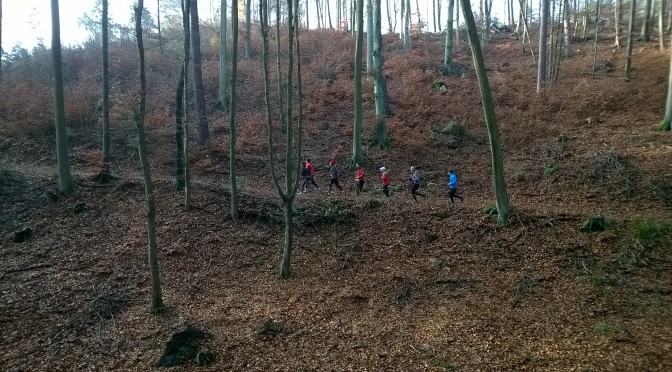Trójmiejskie, polodowcowe wzgórza morenowe tworzą idealne warunki do treningu biegów terenowych, jak i rowerowych MTB. W listopadzie zaplanowane było około 150km, z czego Andrzej zrobił plan a mi się pomyliło i pobiegłem 70 więcej. W grudniu planujemy również ok. 150km. Raz w tygodniu, w weekend biegamy w grupie tzw. długie wybieganie, co zachęciło mnie do zaplanowania nowej trasy.
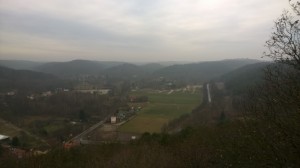
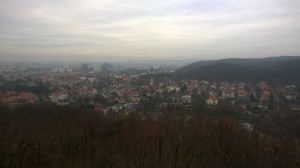
Z Sopotu do Oliwy, niedaleko ZOO, zabytkowej Kuźni Wodnej z 16tego wieku, potem ciągle pod górę starą trasą węglarzy i wzdłuż Obwodnicy powrót do Sopotu – wychodzi jakieś ok. 22km i ze 400m przewyższeń. Takie treningi robimy 1-2 razy w miesiącu a od nowego roku pewnie częściej i dalej. Zanim postawiliśmy stopy na nowych ścieżkach, zapoznaliśmy się z miejscem przenosząc się w dawne czasy i poznając twórcę naszej areny treningowej – ostatni lodowiec.
Wyobraź sobie czytelniku, że jakieś 40-50 tys. lat temu siedzisz sobie w jaskini Cro–Magnon w Dordonii (Francja) i z nudów plakatujesz, tzn. rysujesz koniki a właściwie renifery, bo ta potrawa ma najwięcej gwiazdek w przewodniku Michelin.

Nudzisz się, bo kolejną zimę jesteś uziemiony gdyż służby techniczne nie mogą usunąć zwałowiska śniegu i lodu, które sięgają od Skandynawii po Kielce a czasami i środkową Europę. Przez ostatnie 100 tys. lat akcja zima regularnie opóźnia się, co politycy tłumaczą – taki mamy klimat. Na zewnątrz jest rześko, jakieś 4-5 st.C średniorocznie, no to siedzisz w domu a jak zrobisz wypad na północ to najwyżej za reniferami, które najlepiej sprawdzają gdzie jeszcze lodowisko a gdzie już tundra. W końcu pojawia się przełom, 13,5 tysiąca lat temu sprawy mocno przyspieszyły, lodowiec stopił się na tyle, byś zdecydował się na wakacje w Sopocie.
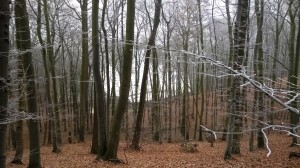
Topniejący lód odsłonił dobrze znane miejsca jak leśną dolinkę z Operą Leśną i sopocki Monciak.Tłumów na deptaku jeszcze nie ma, gdyż tajemnicza interwencja spowodowała, że lodowiec zaczął cofać się z prędkością 1,5m dziennie, a to jest 5 razy szybciej niż zwyczajowo. Zajmujesz miejsce w pustym barze przy oknie, by widzieć kto tam spaceruje – i są lisy polarne, nosorożce włochate, czasami zabłąkany mamut no i są renifery. W ogóle jest świetnie, przy temperaturze 8stC, w słoneczku zrelaksowany wsłuchujesz się w szum potoków, które wypływają spod resztek lodowca i rzeźbią głębokie doliny morenowe ze stokami wysokości 100m. Zauważ, że te dolinki wiją się, meandrują, ale zawsze w końcu kierują się do jeziorka Bałtyk, póki co małego, ale systematycznie powiększającego się. Bardziej na północ 500m grubości czasza lodowca broni dostępu słonym wodom Morza Północnego. W końcu, 11 tysięcy lat temu słychać głosy, pojawiają się pierwsi Pomorzanie – tak ich nazwiemy. Podobno gdzieś tam na południu trwała dyskusja, czy iść za reniferami, czy mamutami. Z tymi mamutami to w ogóle źle wyszło, bo bez racjonalnej akcyzy konsumpcja okazała się nadmierną a spóźnione regulacje nic by już nie pomogły. Okazuje się, że Cromagnończycy poszli dalej na północ za mamutami i z tego powodu ich DNA mocniej świeci na Syberii, Grenlandii, Ameryce, a także w Finlandii i Estonii. Konsternacja, tyle czekania, to kogo witasz w Sopocie? Boczkiem, dosłownie na ciepłą prognozę pogody, pojawili się, lekko wymieszani, przybysze z Indii i Azji Mniejszej dając początek wyższej organizacji i nowemu językowi indo – europejskiemu. Nie jesteś wybredny, no i masz maniery, więc czynisz honory gospodarza a tu nagle spotyka cię afront .. ci przybysze mówią, że nie jesteś pierwszym gościem Sopotu – „między zlodowaceniami, 40-35 tys. lat temu bawili się tu Neandertalczycy ”. OK, nie chcesz psuć atmosfery, tym bardziej, że czujesz w sobie genetyczne procenty [aktualnie 3-6%] neandertalskiego śladu, więc gładko pomijasz temat i rzucasz pytanie o tajemniczą interwencję, która miała miejsce 13,5 tys. lat temu – bez niej byśmy tu nie siedzieli! Uff … temat chwycił, Pomorzanie zamawiają w barze kolejkę i rozpoczynają opowieść. Pierwszy, widać starej daty, w dobrze skrojonej, tradycyjnej skórze z renifera, wspomina coś o plamach na słońcu i zwiększonej jego aktywności no i to wszystko w zbieżności z cyklem Milankovicia opisującym zmiany konta nachylenia osi obrotu ziemi, który zmienia się co 41 tysięcy lat.
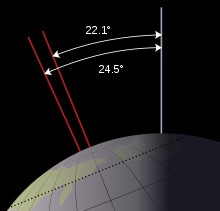
Mniejsze przechylenie powodowało słabsze nasłonecznienie i wprowadzało okres chłodniejszy na półkuli północnej .. – facet chce dalej rozsądnie tłumaczyć, że Neandertale wbiły się dokładnie w cieplejszy okres, że zlodowacenia są przewidywalne, ale … robi się tumult przy barze. Ktoś stara się przywrócić spokój – dajcie mu powiedzieć, niech powie o zasoleniu i odkręceniu Golfstromu– nikt nie słucha, jednocześnie racjonalna argumentacja gdzieś przepada. Teraz głos zabiera trochę niższy, ok. 145cm wzrostu, w futrze z lisów, którego kawałki są pozszywane nićmi ze ścięgien jelenia, całkiem regularnym ściegiem. Okazuje się, że 13,5 tysiąca lat temu szczególna akcja miała miejsce na terenie Niemiec – „to Bonn” – facet ścisza głos. W Bonn ponoć przeprowadzono kontrolowaną katastrofę ekologiczną. Ktoś z tyłu nie dowierza i ripostuje, – w okolicach Bonn, doszło do normalnej erupcji wulkanu – nie siej tu teorii spiskowych. Cokolwiek było przyczyną, zachodnie wiatry zaciągnęły smugę pyłu, która zasłoniło słońce i zrobiło się zimno, ale tylko na chwilkę – pamiętacie te paskudne 1000 lat – gość w lisach cedzi słowa chcąc odzyskać słuchaczy – oni mieli to wszystko pod kontrolą. Dalej, pył opadł i zaległ warstwą grubości 1-2 cm. Ta czarna warstewka na białym śniegu ściągała i znacznie intensywniej zatrzymała promienie słoneczne powodując gwałtowne przyspieszenie topnienia lodowca – majstersztyk! – facet w lisach w końcu triumfuje. To wszystko inaczej, owszem wulkan był, ale generalna praprzyczyna jest inna, zagaja ktoś siedzący niedaleko toalety. Głos mocny, pewny, postura siedzącego nieznana, długie włosy w nieładzie – hipis. – Wenus! Wenus nie ma swojego księżyca! Wolisz zamówić pełną szklankę, bo historia może tego wymagać. Hipis tłumaczy, że mniej więcej chodzi o to, że Wenus nie ma dzisiaj swojego księżyca, ale kiedyś miała – ten nasz. Szybko zamawiasz drugą. Na przestrzeni ostatnich 2 mln lat księżyc, co jakiś czas, był przechwytywany przez Ziemię od Wenus i na odwrót, a w konsekwencji planety raz „cięższe” raz „lżejsze” zmieniały własne orbity pielgrzymowania wokół słońca, cyklicznie przybliżając się i oddalając od ciepłej gwiazdy i to ma tłumaczyć 4 wielkie zlodowacenia. Konsternacja i cisza … niektórzy wymownie pukają się w czoło, kobiety zakładają po cichu pikowane mchem, modne kurtki, z kąta sali pada pytanie – to kiedy przeskok na Wenus, kiedy zlodowacenie?
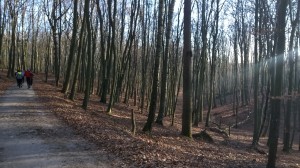
Biegniemy po terenach, które ostatecznie uformowały się zaledwie 13 000 lat temu. Nie przyspieszamy, choć z obliczeń płynie elektryzujący wniosek, że najprawdopodobniej już za 20 000 lat znajdziemy się po lodem. Z każdym kolejnym kilometrem uświadamiamy sobie, że te historie wcale nam nie ułatwiają biegania. Ufamy jednak, że jeśli Was zainteresują, to zostaniecie z naszą opowieścią i troszeczkę pomożecie.
Kolejny wpis ukaże się w przyszły czwartek 18 grudnia. Pozdrawiam Tomek
przykładowy plan tygodniowy: sob – 21km długie wybieganie, teren nie – 13km teren w tym 3km siła biegowa – wt / pt – basen / sala ogólnorozwojowe ćwiczenia – śr / czw – 10km + elementy siły biegowej
Ultra 3 – IN BETWEEN THE ICE AGES
Translation – Anna Meysztowicz
The Tri-City’s post-Ice Age moraine hills create ideal conditions for training trail running as well as mountain bike riding. In November we plan to conquer 150 km, including meeting weekly for a long run, i.e. a running excursion. More kilometres encourage me to plan a new route. From Sopot to Oliwa, not far from the Zoo, the monumental 16th-century Water Forge, then continuously uphill along the old coalmen’s trail, returning to Sopot along the Ring Road – this will probably amount to 22 km and 400 m of elevations. We will do this type of training 1-2 times per month and, from the new year, probably more frequently and for longer distances. However, before we set foot on these paths, it is worth travelling back to the ancient era and meeting the creator of our training arena – the last ice age.
Just imagine, dear reader, that about 40-50 thousand years ago you are sitting in a Cro–Magnon cave in Dordogne (France) and, out of boredom, you are drawing horses or rather reindeer, because this dish has the most stars in the Michelin guide. You are bored because you are stuck as the technical services are unable to remove the mountains of ice and snow that reach from Scandinavia to Kielce and sometimes even Central Europe. For the last 100,000 years the winter campaign is regularly delayed, which the politicians explain as “this being the kind of climate we have.” Outside it’s chilly, around 4-5°C on average and you are stuck at home but when you get around to leaving to travel north, it’s at most to follow the reindeer, who are the best at checking where the ice reaches and where the tundra is. Finally – a breakthrough! Thirteen and a half thousand years ago things sped up dramatically, the glacier melted enough for you to decide on spending holidays in Sopot. The melting ice uncovered well-known areas such as the forest valley with the Forest Opera and the Monciak in Sopot. There are no crowds on the promenade yet as the secret intervention has meant that the glacier began to retreat at the speed of 1.5 m per day, and that is five times faster than usual. You take a place by the window of an empty bar to see who walks past – these are polar foxes, woolly rhinoceroses, sometimes a stray mammoth and of course, reindeer. Generally it is lovely with a temperature of 8°C, relaxing in the sun you listen to the rushing streams that escape from under the remaining glacier and sculpt deep moraine valleys with 100 m high slopes. Note that these valleys meander, but always end up flowing towards the Baltic lake, which is small for now, but is systematically growing bigger. Further north a 500-metre thick glacier defends against access by the salty waters of the North Sea. Finally, 11,000 years ago you could hear voices, the first Pomeranians are appearing – that is what they will be called. Apparently somewhere in the South a discussion was going on about whether to follow the reindeer or the mammoths. Things did not generally end well with those mammoths as, without rational excise tax, consumption proved excessive and delayed regulations would not have helped, now ecologists also warn that this situation could be repeated with the urus, and that once again we will say “It is easy to be wise after the event” (the last urus disappeared in 1627). It turns out that the Cro-Magnons followed the reindeer and the mammoths and their DNA shines stronger in Siberia, Greenland, America and also Finland and Estonia. Consternation, so much waiting, who are you greeting in Sopot? Literally in time for the warm weather forecast, slightly mixed newcomers from India and Asia Minor appear, bringing with them the beginnings of a higher organisation and a new language – Indo-European. You are not fussy, and you are polite, so you play the role of the honourable host and suddenly you are met with an affront – these newcomers are saying that you are not the first guy in Sopot – “between the ice ages 40-35 thousand years ago, the Neanderthals played here”. Ok, you don’t want to spoil the mood, particularly as you can feel the genetic percentages of the Neanderthal footprint within you (at present 3-6%), so you avoid the topic smoothly and ask about the secret intervention that took place 13,500 years ago – without it we would not be sitting here! Phew … they jump on the topic. The Pomeranians order a round at the bar and begin their story. The first, evidently older fashioned, in a well cut traditional reindeer skin, mentions something about patches on the sun and its increased activity and everything connected to the Milankovitch cycle, describing changes in the degree of the angle of the earth’s spinning axis, which changes every 41,000 years, a smaller angle resulted in weaker sunshine and led to a cooler period on the northern hemisphere… – the guy wants to continue his rational explanation that the Neanderthals cut right into the cycle and the warmer period, that ice ages are predictable, but… there is a commotion at the bar. Someone is trying to calm everyone down, “Let him speak about the salinity and reversing the Gulf Stream,” no one is listening, simultaneously rational argumentation falls by the wayside. Now someone a little shorter is taking over, around 145 cm in height, in a fox fur, parts of which have been sewn together with reindeer tendons. It turns out that, 13,5000 years ago, a special activity took place in Germany – “It’s Bonn,” the man lowers his voice. In Bonn apparently a controlled ecological disaster took place. Someone from the back doesn’t believe him and retorts: “What happened in Bonn was a normal volcano eruption – stop spreading your conspiracy theories.” Whatever the cause of this was, the western winds brought over a cloud of dust that covered the sun and it grew cold but only for a moment, “Remember that nasty millennium?” the guy in the fox fur is picking his words trying to win back his audience, “They had everything under control.” Further on the dust fell in a coat of 1-2 cm thickness. That black layer on the white snow attracted and much more intensely held the sun rays giving rise to a sudden increase in the melting speed of the glacier– “Humdinger!” the man in the fox triumphs. “That’s not how it was, of course the volcano erupted but the real reason was different,” says someone sitting near the toilet. A strong, sure voice, the physique of this person unknown, long unkempt hair – a hippie. “Venus! Venus doesn’t have its own moon!” You prefer to order another drink because this story may require you to. The hippie explains that, more or less, the issue is that Venus doesn’t have its own moon but did once – our moon. You quickly order another. Over the recent 2 million years the moon, from time to time, was taken over by the Earth from Venus and the other way around, as a consequence of which the plants, at times “heavier” and at times “lighter” changed their own orbits of pilgrimage around the sun, cyclically nearing and moving away from the hot star and this is the explanation for four huge ice ages. Consternation and silence… some are tapping their foreheads, women are slowly donning modern jackets made of quilted moss, a question arises from the corner of the room – “So when was the jump to Venus, when was the ice age?”
We are running on the trails that were finally formed just 13,000 years ago. We are not speeding up although the calculations give rise to the electrifying conclusion that most probably in just 20,000 years we will be under the ice. With each subsequent kilometre we realise that these running stories don’t make it any easier for us. We trust, however, that if you are interested in them, you will stay with us and help a little.
